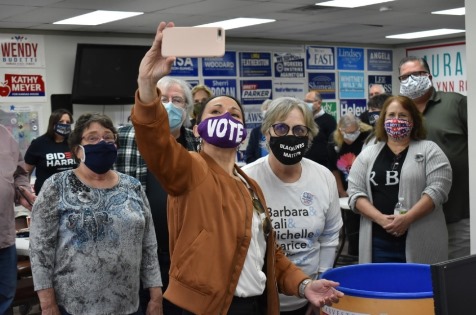Wyandotte County residents on Tuesday evening told a legislative redistricting committee they wanted Wyandotte County to stay together with Johnson County in the 3rd Congressional District.
The legislative redistricting listening tour went to Bonner Springs and Stilwell on Tuesday evening to hear comments from residents. It was the second round of redistricting listening tour meetings. Committee members listened to comments by video from Topeka, while residents made comments from their communities.
Connie Brown Collins, a resident of the Welborn area of Kansas City, Kansas, implored the committee to “keep Wyandotte County whole.”
After census results came in, it was found the 3rd District is about 57,816 persons over the ideal population of 734,470, about 7 percent over the ideal, according to Jordan Milholland of the Kansas Legislative Research Department. The 3rd District will have to give the extra population to another district or districts in the state.
Collins, who is with the Voting Rights Network of Kansas, said that western and southern townships in Johnson County could be moved into another congressional district. Currently the 3rd District includes Wyandotte, Johnson and parts of Miami County.
Collins echoed a speaker at the Stilwell location, Amy Carter of Overland Park, who said areas including DeSoto and Louisburg might be moved into another district. The most populous parts of Johnson and Wyandotte counties should be kept together in the 3rd District, while the more rural parts of Johnson County could be moved into another district, Carter suggested.
Also speaking was Dr. Bruce Carter of Overland Park, who said the 3rd District’s diversity needs to be maintained. He noted the district was winnable by either party now. He asked that the voters be allowed to make their decisions and choose their representative; the representative should not be determined by the lines drawn by the legislative committee.
“We voters should be making that decision,” he said.
Collins said Wyandotte and Johnson counties share employment and transportation systems, and as part of the Greater Kansas City area should remain in the same district.
Henry Chamberlain, Bonner Springs, talked about diversity in Wyandotte County, and the difference between rural and urban areas. It would probably be impossible for a representative from rural Kansas to fully understand and represent his interests in an urban area, he said.
Chamberlain told the committee he had expected to be one of the people funding litigation in case the district’s boundary lines were gerrymandered. He urged the committee to keep Wyandotte and Johnson counties together in the 3rd District. He told the committee that they had the ability to avoid delay, litigation and expenditure of public resources, plus there was the opportunity to restore the faith of Kansans in their Legislature.
Alex Overman, who lives in Lenexa and works in Wyandotte County, offered several redistricting maps for the committee. One of them, for example, kept all the cities intact and together, while removing Gardner, DeSoto and Edgerton from the 3rd District.
“If we break up Johnson and Wyandotte counties, someone’s going to be misrepresented,” he said.
Mike Taylor, a retired public relations director for the Unified Government, was representing the Voter Rights Network of Wyandotte County.
He told the committee that Wyandotte and Johnson counties are not only neighbors, they have strong community interests. They share sewer systems, transportation networks, infrastructure networks, and a lot is dependent on federal funding, Taylor said. It’s important to have one federal representative to fight for that funding, he said. Twenty-two mayors in both counties meet on a monthly basis.
Taylor felt that it would be pretty easy to solve the redistricting challenges unless there is an attempt to gerrymander, and “we urge you not to do that.”
After the committee has drawn the maps, Taylor asked it to hold another round of public hearings.
Cassandra Woolworth of Johnson County said the biggest issue was keeping Wyandotte and Johnson counties together.
“We don’t want gerrymandering,” she said. “We don’t want any kind of slanted political view. Aren’t we done with that yet, don’t we already have enough partisan politics.”
She recalled the courts had to decide the issue in 2012. There had been a proposal to put Wyandotte County in with a district in western Kansas.
“I don’t want history to repeat itself,” she said.
“Gerrymandering is cheating,” she said. “We teach our children not to cheat. We can’t show them that cheating is the way to win.”
State Rep. Chris Croft, R-8th Dist., chair of the House redistricting committee, conducted the legislative redistricting listening tour.
State Rep. Tom Burroughs, D-33rd Dist., is the House redistricting committee ranking minority member.
The committee also is still taking written comments at kslegresearch.org.
The listening tour from Bonner Springs and Stilwell is online at https://www.youtube.com/watch?v=r8haWh3w7Ts.

